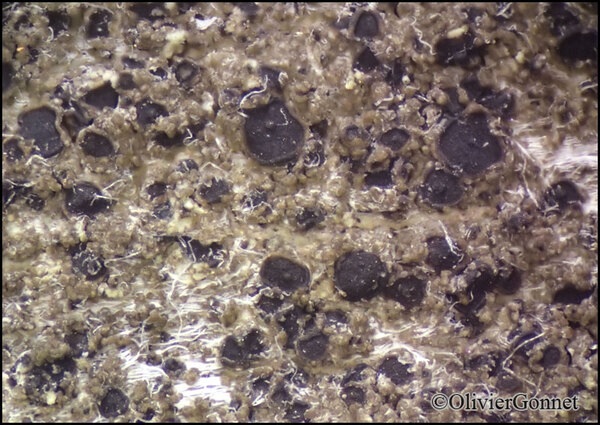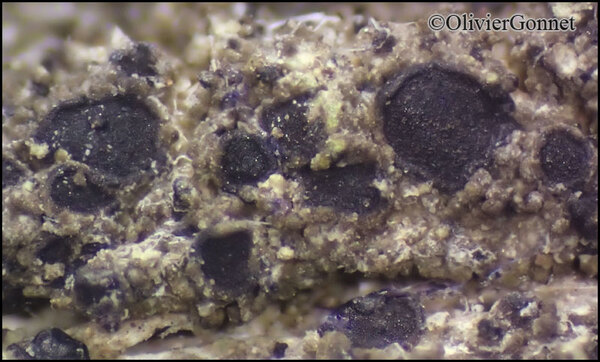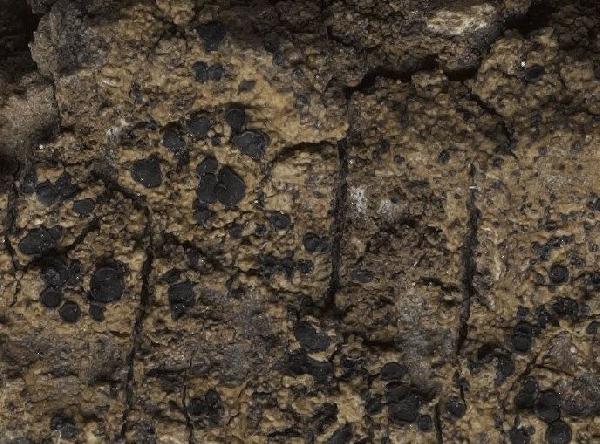Rinodina nimisii Giralt & H. Mayrhofer
in Giralt & al., Lichenologist, 27: 16, 1995.
Synonyms:
Distribution: N - Lig (Giordani & Incerti 2008, Giordani & al. 2009). C - Sar (Giralt & al. 1995).
Description: Thallus crustose, episubstratic, well-developed, continuous, greyish-green, brownish or olivaceous, indeterminate, entirely blastidiate, without a distinct prothallus. Blastidia up to 125 µm thick, with a slightly pruinose and rugose appearance due to surrounding projecting hyphae. Apothecia at first lecanorine, usually becoming biatorine when old, not abundant, scattered or rarely confluent, subimmersed to broadly attached, up to 1 mm across, with a black, concave to flat, rarely convex disc and a thin, entire or blastidiate, soon excluded thalline margin; proper margin usually visible as a parathecial ring between disc and thalline margin. Thalline exciple 30-70 µm wide laterally; proper exciple up to 10-20 µm wide laterally, expanded to 20-30 µm in upper part; epithecium brownish black, K-; hymenium colourless, 50-75 µm high; paraphyses up to 2 µm thick at mid-level, the apical cells 3-5 µm wide; hypothecium colourless, 80-100 µm high. Asci 8-spored, clavate, the K/I+ blue tholus penetrated by a faintly amyloid apical cushion with parallel or diverging flanks, the wall K/I-, surrounded by a K/I+ blue outer layer, Lecanora-type. Ascospores 1-septate, brown, ellipsoid, (10-)12-16(-18) x 6-8.5 µm, without a well-developed torus, swollen in K and strongly warted when mature, Dirinaria-type, with ontogeny of type B (apical thickenings visible before the insertion of the septum). Photobiont chlorococcoid. Spot tests: K-, C-, KC-, P-, UV-. Chemistry: without lichen substances.Note: a Mediterranean-Macaronesian lichen known from several Mediterranean Islands (Corsica Sardinia, Menorca), Portugal, and the Canary Islands, restricted to coastal localities with frequent humid, salt-laden winds, e.g. on Juniperus in sites with sand dunes. It is included in the Italian red list of epiphytic lichens as “Endangered” (Nascimbene & al. 2013c).
Growth form: Crustose
Substrata: bark
Photobiont: green algae other than Trentepohlia
Reproductive strategy: mainly asexual, by soredia, or soredia-like structures (e.g. blastidia)
Most common in areas with a humid-warm climate (e.g. most of Tyrrenian Italy)
Taxon bound to maritime-coastal situations
Commonnes-rarity: (info)
Alpine belt: absent
Subalpine belt: absent
Oromediterranean belt: absent
Montane belt: absent
Submediterranean belt: absent
Padanian area: absent
Humid submediterranean belt: absent
Humid mediterranean belt: extremely rare
Dry mediterranean belt: absent

Predictive model
Herbarium samples

Courtesy Danièle et Olivier Gonnet - Source: https://www.afl-lichenologie.fr/Photos_AFL/Photos_AFL_R/Textes_R2/Rinodina_nimisii.htm
France, Belvédère Campo Moro, punta di Campo Moro, alt. 15 m - Corse

Courtesy Danièle et Olivier Gonnet - Source: https://www.afl-lichenologie.fr/Photos_AFL/Photos_AFL_R/Textes_R2/Rinodina_nimisii.htm
France, Belvédère Campo Moro, punta di Campo Moro, alt. 15 m - Corse

Courtesy Danièle et Olivier Gonnet - Source: https://www.afl-lichenologie.fr/Photos_AFL/Photos_AFL_R/Textes_R2/Rinodina_nimisii.htm
France, Belvédère Campo Moro, punta di Campo Moro, alt. 15 m - Corse


P.L. Nimis; Owner: Department of Life Sciences, University of Trieste
Herbarium: TSB (7336)
2001/11/30
isotype
Growth form: Crustose
Substrata: bark
Photobiont: green algae other than Trentepohlia
Reproductive strategy: mainly asexual, by soredia, or soredia-like structures (e.g. blastidia)
Most common in areas with a humid-warm climate (e.g. most of Tyrrenian Italy)
Taxon bound to maritime-coastal situations
Commonnes-rarity: (info)
Alpine belt: absent
Subalpine belt: absent
Oromediterranean belt: absent
Montane belt: absent
Submediterranean belt: absent
Padanian area: absent
Humid submediterranean belt: absent
Humid mediterranean belt: extremely rare
Dry mediterranean belt: absent

Predictive model
| Herbarium samples |

Courtesy Danièle et Olivier Gonnet - Source: https://www.afl-lichenologie.fr/Photos_AFL/Photos_AFL_R/Textes_R2/Rinodina_nimisii.htm
France, Belvédère Campo Moro, punta di Campo Moro, alt. 15 m - Corse

Courtesy Danièle et Olivier Gonnet - Source: https://www.afl-lichenologie.fr/Photos_AFL/Photos_AFL_R/Textes_R2/Rinodina_nimisii.htm
France, Belvédère Campo Moro, punta di Campo Moro, alt. 15 m - Corse

Courtesy Danièle et Olivier Gonnet - Source: https://www.afl-lichenologie.fr/Photos_AFL/Photos_AFL_R/Textes_R2/Rinodina_nimisii.htm
France, Belvédère Campo Moro, punta di Campo Moro, alt. 15 m - Corse


 INDEX FUNGORUM
INDEX FUNGORUM
 GBIF
GBIF





